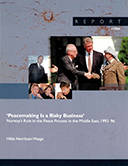Hilde Henriksen Waage's latest research on Norway's role in the peace process in the Middle East, 1993-96 On 13 September 1993, a major turning point seemed to have been reached in Israeli – Palestinian relations. The world would witness an extraordinary breakthrough in the apparently insoluble Middle East conflict as the Oslo Agreement was signed at the White House in Washington, DC. Rarely had the Middle East known such a moment of hope. Among the prominent international actors strolling in the sun on the White House lawn on that bright September day was Norway’s foreign minister, Johan Jørgen Holst. Norway had made a decisive contribution to this, one of the most serious attempts at making peace in the strife-torn Middle East region since the creation of the State of Israel in May 1948. What had made Norway, of all countries, suitable for such an extraordinary task? And what kind of role had Norway played? Why did both Israelis and Palestinians find Norway, of all countries, acceptable as a mediating partner? And how can the outcome of the process be explained? In order to provide a meaningful analysis of Norway’s role, it is necessary to examine the development of the peace process itself. The Oslo peace process reflected the fundamentally asymmetrical power situation that existed between the Israelis and the Palestinians. Israel was the stronger party; it possessed a clear national security agenda and was unwilling to make too many concessions. The PLO, on the other hand, despite its strong vision of a future Palestinian state, was willing to make significant concessions in order to avoid further marginalization of itself and the Palestinian cause. What room for manoeuvre did such a basic asymmetry of power provide for the Norwegians?
Waage, Hilde Henriksen (2004) Peacemaking Is a Risky Business: Norway’s Role in the Peace Process in the Middle East, 1993–96. PRIO Report: 1. Oslo: PRIO.








